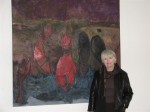Beauty, sorrow and American detritus
Waiting to be hung on the “Wall of Fame” in my condo unit are a trio of Milwaukee-based photographer Kevin J. Miyazaki’s prints. Two are from his Fast Food series and one from his Camp Home series. When Grava Gallery expertly installs them, Miyazaki’s three will join black and white images by Francis Ford, William Klein, Jim Herrington, Shimon & Lindemann and two from the ’50s by artist unknown. The most recent addition is Brian Jacobson’s print of a cigarette butt stubbed out in an ice-cream bar. It ran with a piece I wrote for this magazine.
Then too, it was thrilling to see Miyazaki’s images of a spectacular modernist Racine home, included in a late August article in the New York Times.
I think my fascination with photography, specifically those in black and white, springs from WWII-era Life Magazine images. And then there were those eagerly awaited images from the days when Brownie camera film had to be developed and the results picked up at our local drugstore. Certainly, having to wait added to the magic of the experience, and though the Polaroid gave us warp speed results (and the marvelous ’70s work of Lucas Samaras), in retrospect, the Polaroid event was akin to eating real mashed potatoes vs. potato flake stuff made in a minute.
Miyazaki and I discuss internment camps, his charity-based photography website and the beauty and sorrow in defunct fast food establishments.
I saw elements of your “Camp Home” series at Inova Kenilworth, and thought it was a stunning memorial to not only your dad, but to those others forced by our government to live in confinement during WWII. Have you pursued that series further?
I made my fourth trip to the area around the former Tule Lake internment camp in June to make new pictures. I also learned more about the history of the camp by attending the annual Tule Lake pilgrimage, which brought 350 people to the area for reflection, discussion and community building. I met lots of people from my father’s generation (including a few who knew him), who told be about their wartime experiences. I’ll have work from the series in a group show in Seattle in October.
And on a related note, I’m reading a fascinating book, Moving Images: Photography and the Japanese American Incarceration, by UWM associate professor Jasmine Alinder.
The images I own are so quiet….I guess I should say, serene, but that’s not right either as there is an air of uneasy nostalgia about all three. Perhaps though, the nostalgia I feel looking at the Fast Food series (the outline of a defunct McDonald’s sign; a stack of Burger King boxes) isn’t what you intended to convey.
It can just as easily be argued that the images are big statement about our consumer society. Does it matter to you what I “see” when I study them?
I’m glad the images raised some questions for you. My desire to document the spaces in Fast Food stems from an interest in their corporate design. Even devoid of color, the shapes of buildings, rooflines, empty signs, even chairs and tables, denote specific restaurant chains. I’m interested in how ingrained and familiar such design has become in our collective, contemporary memory.
And the closing of a fast food location raises lots of interesting issues about popular, but not public space. No one rallies to save a Burger King, yet they likely spend more time there than in a local museum or library. When they close, they just close – I’ve seen buildings with lights left on, items left behind, handwritten notes taped to the door. There’s appears to be no “corporate” manner of ending the life of these restaurants.
I travel a lot for my magazine assignments, and once you start looking for closed-down fast food restaurants, they rapidly begin appearing. I’ve only made two specific trips to shoot restaurants, so mostly I’m finding them at random. And through my blog, kind readers have e-mailed me with locations around the country.
I’ve been following your career for quite a few years now, meeting you via Milwaukee Magazine where we both labored. Local photographers were arguing about the merits of digital photography. That’s a dead argument these days. What, besides your own great images, are you doing to spread the word about the merits of excellent photography?
This past December, I founded collect.give, a charity-based website that allows photographers to offer limited edition prints at an affordable price – while pledging 100 percent of the proceeds to a charity they choose. The site makes use of the technology of entities like PayPal, Facebook and WordPress, and it builds on successful online gallery sites like Jen Bekman’s 20×200.
It’s a portal for photographers that collectively brings more viewers to the photographs than any single photographer could do on their own blog or website. To date, we’ve had nearly 30,000 visits to the website and we’ve raised over $11,000 for 23 unique charities.
Unique? Is there a commonality that makes them the selected charities unique?
Each photographer chooses the organization they pledge their donation to, so there’s an interesting variety. It runs the gamut, with organizations supporting good work in the fields of the environment, housing, education and medical research. Mostly, it’s smaller organizations that you’ve likely not heard of, which makes it all the more interesting.






















